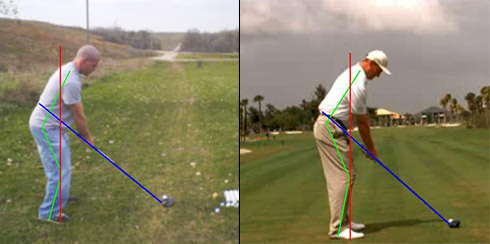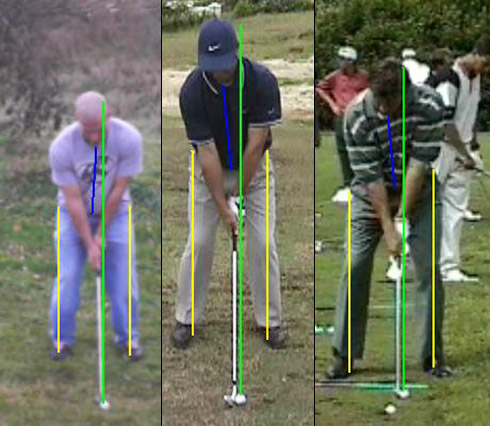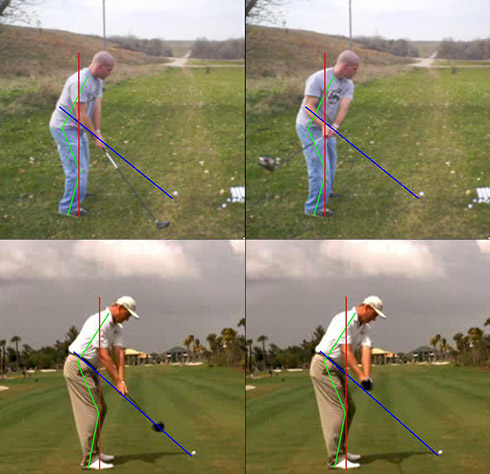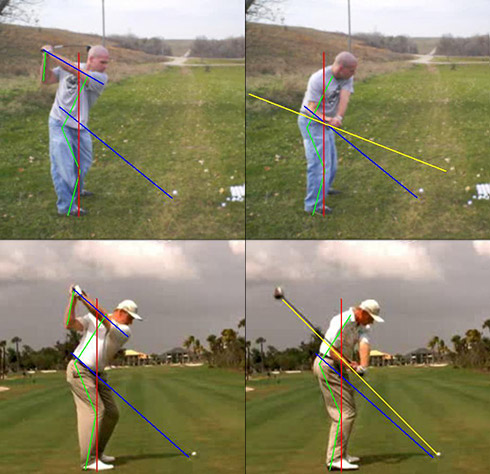 In this Swing Check we look at the golf swings of Troy Worden. As is the case with most golfers, many of the positions we’ll see throughout the swing are a result of the address position. Troy can make huge strides in swing consistency, power, and accuracy by working on the address position.
In this Swing Check we look at the golf swings of Troy Worden. As is the case with most golfers, many of the positions we’ll see throughout the swing are a result of the address position. Troy can make huge strides in swing consistency, power, and accuracy by working on the address position.
Below is Troy’s swing sequenced at key positions:
Troy Worden iron: face-on.
Troy Worden driver: down the line.
Read on for a more complete analysis of Troy’s action.
Setup from Down the Line
From the down-the-line view Troy’s upper body and arms are in sound positions, but the lower-body position will lead to problems during the swing. The knees are pitched forward (toward the ball) too much, and the hips are set low and close to horizontal in angle. The position of the hips and knees will promote overactive lower body motion in the backswing.
The horizontal hip angle and low hip position will promote:
- Horizontal turning of the body
- Troy’s arms to swing deep behind his body
- The club to swing underneath the original shaft angle plane (blue line shown in the picture).

In comparison the pros (Ernie Els shown) have the hips held in a higher position. The higher hip position places the kneecaps in line with the balls of the feet. The tall posture and tilt from the hips promotes the belt to be tilted on a line close to the shaft angle at address.
This tall posture helps:
- the lower body to remain stable (creating resistance and coil)
- the body to move perpendicular around the tilted spine
- the club with swing back along the original shaft angle plane
Setup from Face On
From face on Troy looks to have a good ball position, but again his posture is a problem. The right hip is set too far back (over the outside of the right foot shown by the yellow line), and the spine is tilted toward the target. I’ve drawn a line (blue) up from the center of Troy’s pants (near where the zipper would be located) to the center of his head. As we see the head and nose are slightly forward of the lower body center. These positions promote lateral movement in the swing.

Above we have face-on iron setups of Masters Champions Trevor Immelman (center) and Nick Faldo (right). The difference we see is the edge of the right hip lines up with the instep of the back foot, and the upper spine is tilted away from the target at address. Having the right hip and knee bumped toward the target establishes a brace against lateral movement in the backswing (promoting hip rotation instead of sliding starting back).
Having the spine tilted away from the target helps in three significant ways:
- It makes it easier to get wound up in the backswing
- makes it easier to stay behind the ball in the downswing
- decrease the chance of the body sliding (which could lead to a loss of balance and posture during the swing
Backswing
The pictures below show Troy swinging the club underneath the original shaft angle plane, the shoulders and hips turning horizontal to the ground, the hips over rotating, and the back leg straightening. All of these are the results of the way Troy setup.

Els tall angular posture (as noted in the setup section) has helped to keep his lower body stable, to turn his shoulders level (perpendicular to his tilted spine), and to swing the club back along the original shaft plane. All motions that were promoted by good setup positions.
Downswing
The chain reations continue in the downswing. Troy’s overactive lower body could lead to two things. Either his lower body will fall behind, or it will move too quickly and out race, the upper body. In this swing his lower body out races his arms and upper body. That makes Troy’s swing heavily dependent on timing, and that makes solid and repeatable contact difficult from one swing to the next.

Summary and Conclusion
By working on his posture at setup, Troy will be able to make a more efficient backswing. A more efficient backswing means he will be able to stay in better balance, which in turn will mean he will be in a position to transfer more power to the club at impact for power and increased consistency.
If you’re interested in having your swing analyzed in a future edition of Swing Check here on The Sand Trap, check out the requirements page and submit your videos today!

Nice job Tom.
In my opinion, something else worth mentioning is the appearance of the right leg at the top of Troy’s backswing. Even with a more correct address position (which no doubt would help Troy create a better impact position), the fact that the right leg has locked up is a clue that something is out of position. I say this not to be critical of Tom or Troy, but more as a general reminder to those of us concerned with better ball-striking. If you can’t arrive at the top of your backswing with a reasonable amount of flex in the right knee, you will most likely need to make substantial compensations to strike the ball well. Hip rotation and stability are keys to consistency, and a locked right leg is a good sign the hips are tight and weak.
Play well, Troy.
Tom,
Let me start by saying thank you for taking the time to break down my swing and the problems associated with it. I recently had surgery to repair a herniated disk in my neck so i will not be able to work on my swing much. I can however work on my posture and set up which appears to be a large part of the problem with my swing. I have improved some this year getting my handicap back down from a 15 to a 12…but that was mostly due to short game improvments. I look forward to working on the very simple things you pointed out and playing again in late September. I will let you know how it goes.
Thanks again,
Troy Worden
P.S.
In golf I have not failed. I have just found 10,213 ways that don’t work!
Improved posture should automatically correct the movement of the right knee/leg. The hips being set low and back at setup was likely related to the right leg straightening and the knee flex being lost. An improved setup (posture) should lead to knee flex being maintained, so it shouldn’t be a concern for Troy in the future.